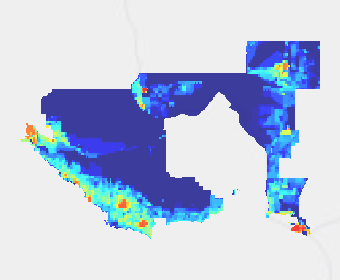 Center for Health
Center for Health
and the Global
EnvironmentClimate Health and Risk Tool
and the Global
EnvironmentClimate Health and Risk Tool

Photo: John Towner
Explore models by topic
topics: Example Models (2), Heat-related risks (1), Historical heat-related risks (1), WA Census Tracts 2021 Heat Dome Heat-Health Risks (2), WA Census Tracts Future Heat-Health Risks (2), WA Census Tracts Historical Heat-Health Risks (2), WA Legislative Districts 2021 Heat Dome Heat-Health Risks (6), WA Legislative Districts Future Heat-Health Risks (2), WA Legislative Districts Historical Heat-Health Risks (4)Example Models
(showing 2 of 2)King County Washington Tree planting Priority - 2036-2065 - Hottest 3 days of each year (15 arcsecond grid) (version 5.00)for King County, WA
created 07/11/2023 by Tim Sheehan, Jeremy Hess
created 07/11/2023 by Tim Sheehan, Jeremy Hess
Unvetted, example model for tree planting priority in King County, Washington State based on heat-health risk determined using the hottest 3 days of each reporting unit over the period 1990-2020
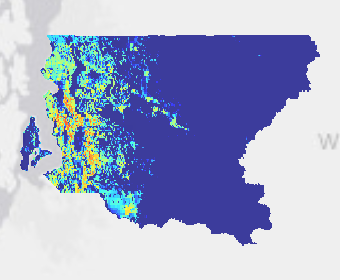
Pierce County, WA Heat Health Risk - 1991-2020 - Hottest 3 days of each year (15 arcsecond grid) (version 5.00)for Pierce County, Washington
created 03/22/2023 by Tim Sheehan, Alyssa Miller, Jeremy Hess
created 03/22/2023 by Tim Sheehan, Alyssa Miller, Jeremy Hess
This model characterizes the most intense short-term risk by considering the hottest three days for each reporting unit in each year between 1991 and 2020 for Pierce County, WA.
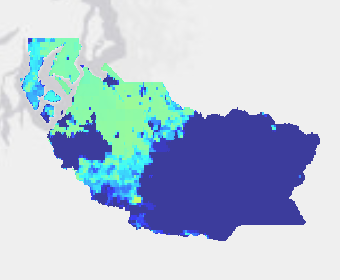
WA Census Tracts 2021 Heat Dome Heat-Health Risks
(showing 2 of 2)WA Census Tracts Heat Health Risk - 2021-06-28 (version 5.1)for Washington State
created 09/21/2023 by Tim Sheehan, Alyssa Miller, Jeremy Hess
created 09/21/2023 by Tim Sheehan, Alyssa Miller, Jeremy Hess
This model characterizes daily heat health risk on June 28, 2021 during the heat dome event.
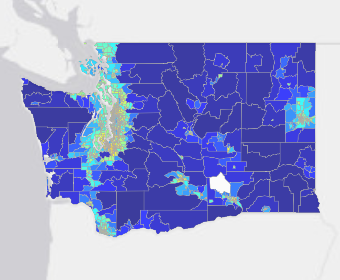
WA Census Tracts Heat Health Risk - 2021-06-23 (version 5.1)for Washington State
created 09/08/2023 by Tim Sheehan, Alyssa Miller, Jeremy Hess
created 09/08/2023 by Tim Sheehan, Alyssa Miller, Jeremy Hess
This model characterizes daily heat health risk on June 23, 2021 during the heat dome event.
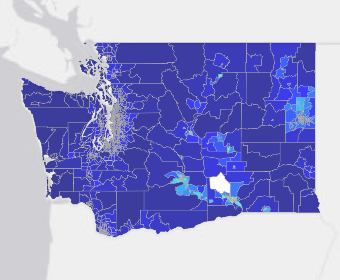
WA Census Tracts Future Heat-Health Risks
(showing 2 of 2)WA Census Tracts Heat Health Risk - 2036-2065 - Hottest 3 days of each year (version 5.1)for Washington State
created 09/21/2023 by Tim Sheehan, Alyssa Miller, Jeremy Hess
created 09/21/2023 by Tim Sheehan, Alyssa Miller, Jeremy Hess
This model characterizes the most intense future short-duration risk by considering the hottest projected three days for each reporting unit in each year between 2036 and 2065.

WA Census Tracts Heat Health Risk - 2036-2065 - Hottest 30 days of each year (version 5.1)for Washington State
created 09/21/2023 by Tim Sheehan, Alyssa Miller, Jeremy Hess
created 09/21/2023 by Tim Sheehan, Alyssa Miller, Jeremy Hess
This model characterizes the most intense future long-duration risk by considering the hottest projected thirty days for each reporting unit in each year between 2036 and 2065.
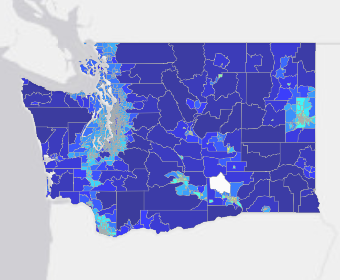
WA Census Tracts Historical Heat-Health Risks
(showing 2 of 2)WA Census Tracts Heat Health Risk - 1991-2020 - Hottest 30 days of each year (version 5.1)for Washington State
created 09/21/2023 by Tim Sheehan, Alyssa Miller, Jeremy Hess
created 09/21/2023 by Tim Sheehan, Alyssa Miller, Jeremy Hess
This model characterizes the most intense long-duration risk by considering the hottest thirty days for each reporting unit in each year between 1991 and 2020.
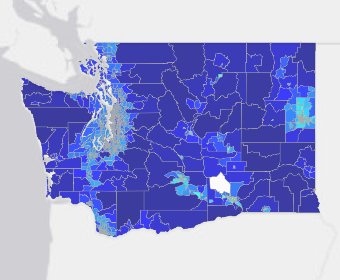
WA Census Tracts Heat Health Risk - 1991-2020 - Hottest 3 days of each year (version 5.1)for Washington State
created 09/21/2023 by Tim Sheehan, Alyssa Miller, Jeremy Hess
created 09/21/2023 by Tim Sheehan, Alyssa Miller, Jeremy Hess
This model characterizes the most intense short-term risk by considering the hottest three days for each reporting unit in each year between 1991 and 2020.
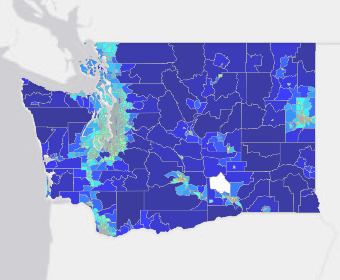
WA Legislative Districts 2021 Heat Dome Heat-Health Risks
(showing 3 of 6)WA Legislative Districts Heat Health Risk - 2021-06-23 (version 5.1)for Washington State
created 09/21/2023 by Tim Sheehan, Alyssa Miller, Jeremy Hess
created 09/21/2023 by Tim Sheehan, Alyssa Miller, Jeremy Hess
This model characterizes daily heat health risk on June 23, 2021 during the heat dome event.
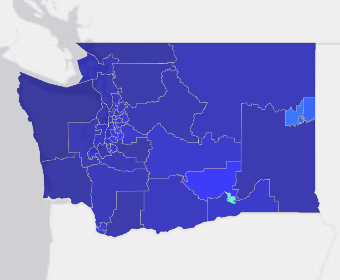
WA Legislative Districts Heat Health Risk - 2021-06-28 (version 5.1)for Washington State
created 09/21/2023 by Tim Sheehan, Alyssa Miller, Jeremy Hess
created 09/21/2023 by Tim Sheehan, Alyssa Miller, Jeremy Hess
This model characterizes daily heat health risk on June 28, 2021 during the heat dome event.
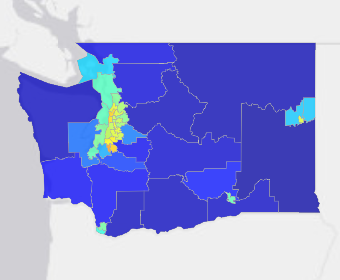
WA Legislative District 15 Heat Health Risk - 2021-06-23 (version 5.1)for Washington State
created 09/08/2023 by Tim Sheehan, Alyssa Miller, Jeremy Hess
created 09/08/2023 by Tim Sheehan, Alyssa Miller, Jeremy Hess
This model characterizes daily heat health risk on June 23, 2021 during the heat dome event.

WA Legislative Districts Future Heat-Health Risks
(showing 2 of 2)WA Legislative Districts Heat Health Risk - 2036-2065 - Hottest 3 days of each year (version 5.1)for Washington State
created 09/21/2023 by Tim Sheehan, Alyssa Miller, Jeremy Hess
created 09/21/2023 by Tim Sheehan, Alyssa Miller, Jeremy Hess
This model characterizes the most intense future short-duration risk by considering the hottest projected three days for each reporting unit in each year between 2036 and 2065.
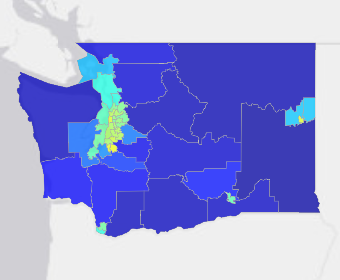
WA Legislative Districts Heat Health Risk - 1991-2020 - Hottest 30 days of each year (version 5.1)for Washington State
created 09/21/2023 by Tim Sheehan, Alyssa Miller, Jeremy Hess
created 09/21/2023 by Tim Sheehan, Alyssa Miller, Jeremy Hess
This model characterizes the most intense future long-duration risk by considering the hottest projected thirty days for each reporting unit in each year between 2036 and 2065.
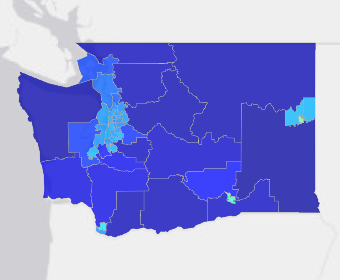
WA Legislative Districts Historical Heat-Health Risks
(showing 3 of 4)WA Legistaltive Districts Heat Health Risk - 1991-2020 - Hottest 30 days of each year (version 5.1)for Washington State
created 09/21/2023 by Tim Sheehan, Alyssa Miller, Jeremy Hess
created 09/21/2023 by Tim Sheehan, Alyssa Miller, Jeremy Hess
This model characterizes the most intense long-duration risk by considering the hottest thirty days for each reporting unit in each year between 1991 and 2020.

WA Legislative Districts Heat Health Risk - 1991-2020 - Hottest 3 days of each year (version 5.1)for Washington State
created 09/21/2023 by Tim Sheehan, Alyssa Miller, Jeremy Hess
created 09/21/2023 by Tim Sheehan, Alyssa Miller, Jeremy Hess
This model characterizes the most intense short-term risk by considering the hottest three days for each reporting unit in each year between 1991 and 2020.

WA Legislative District 15 Heat Health Risk - 1991-2020 - Hottest 3 days of each year (version 5.1)for Washington State
created 12/05/2022 by Tim Sheehan, Alyssa Miller, Jeremy Hess
created 12/05/2022 by Tim Sheehan, Alyssa Miller, Jeremy Hess
This model characterizes the most intense short-term risk by considering the hottest three days for each reporting unit in each year between 1991 and 2020.
